Individual Strategic Management Report: Lidl's China Strategy
VerifiedAdded on 2023/01/19
|15
|4552
|78
Report
AI Summary
This individual strategic management report provides a comprehensive analysis of Lidl's potential expansion into the Chinese market. It begins with an executive summary and an introduction to strategic management, emphasizing its role in business growth. The report then delves into an external environmental analysis using PESTLE and Porter's Five Forces models to assess the political, economic, social, technological, legal, and environmental factors, as well as the competitive dynamics within the retail industry. An internal environmental analysis utilizes the VRIO model to evaluate Lidl's resources and capabilities, identifying its strengths and competitive advantages. The report also identifies competitive strategies using Bowman's Clock model and concludes with strategic directions and a final conclusion, highlighting key findings and recommendations for Lidl's expansion strategy. The report underscores Lidl's potential in the Chinese market, the challenges it may face, and the strategic approaches it can adopt to ensure successful market entry and growth.
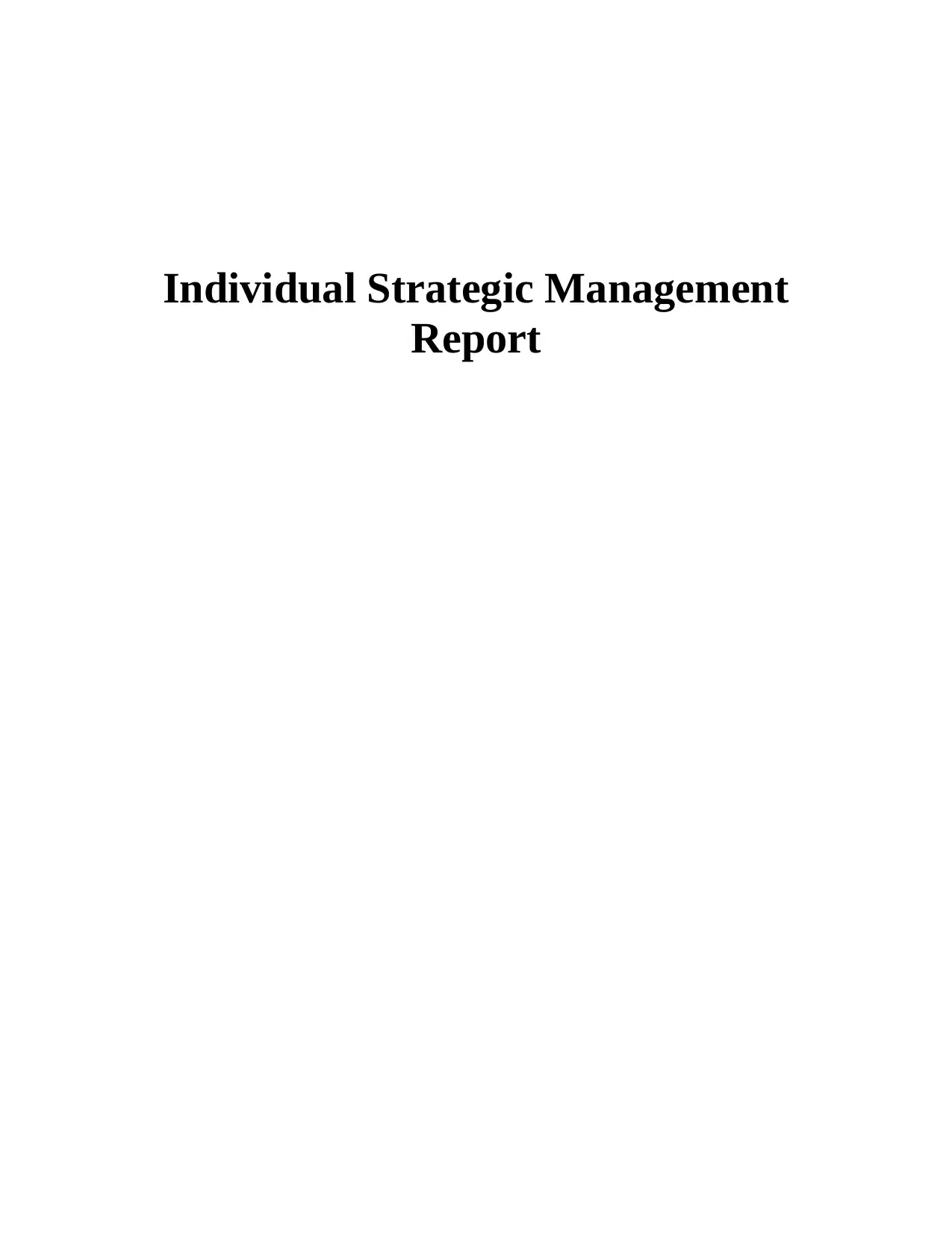
Individual Strategic Management
Report
Report
Paraphrase This Document
Need a fresh take? Get an instant paraphrase of this document with our AI Paraphraser
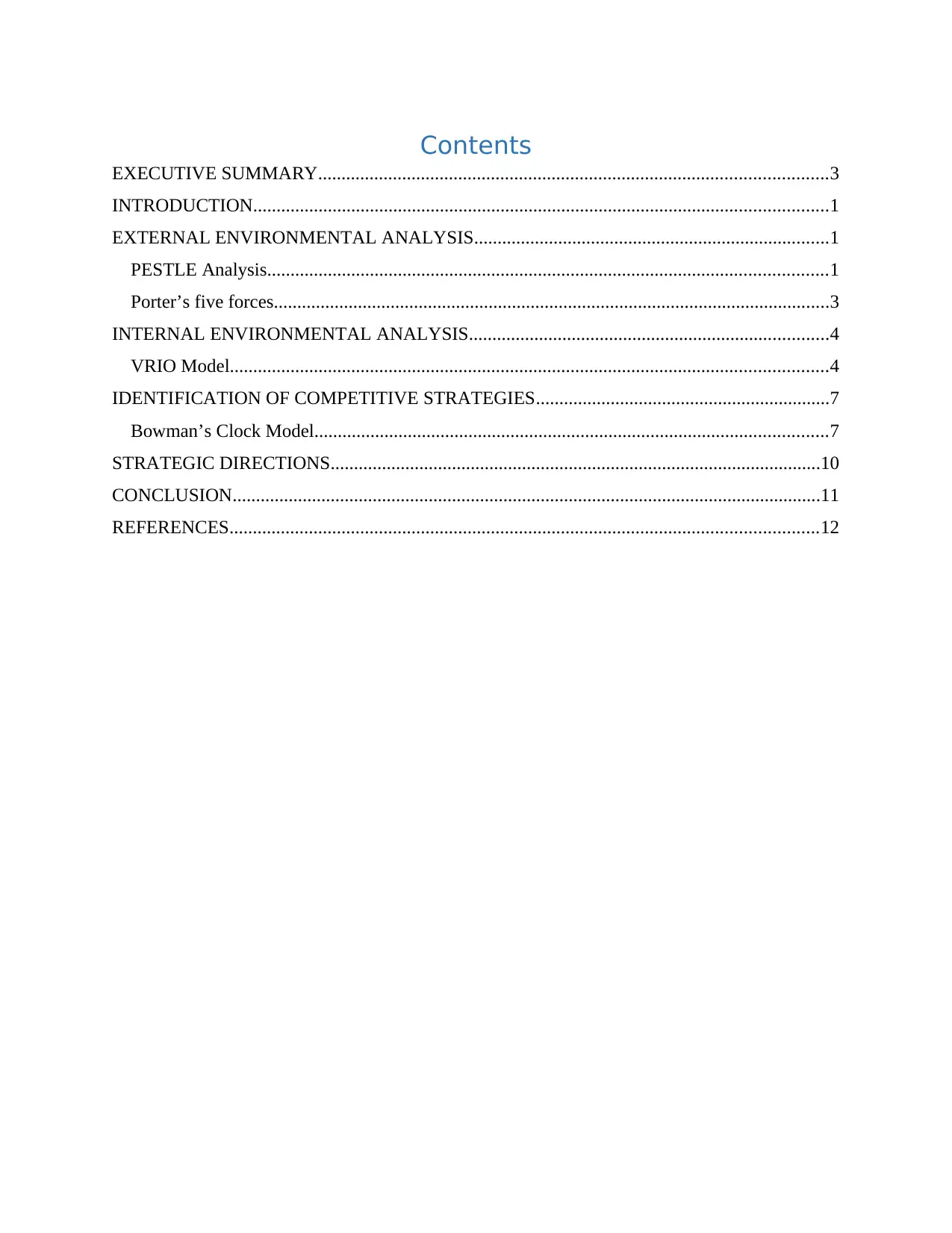
Contents
EXECUTIVE SUMMARY.............................................................................................................3
INTRODUCTION...........................................................................................................................1
EXTERNAL ENVIRONMENTAL ANALYSIS............................................................................1
PESTLE Analysis........................................................................................................................1
Porter’s five forces.......................................................................................................................3
INTERNAL ENVIRONMENTAL ANALYSIS.............................................................................4
VRIO Model................................................................................................................................4
IDENTIFICATION OF COMPETITIVE STRATEGIES...............................................................7
Bowman’s Clock Model..............................................................................................................7
STRATEGIC DIRECTIONS.........................................................................................................10
CONCLUSION..............................................................................................................................11
REFERENCES..............................................................................................................................12
EXECUTIVE SUMMARY.............................................................................................................3
INTRODUCTION...........................................................................................................................1
EXTERNAL ENVIRONMENTAL ANALYSIS............................................................................1
PESTLE Analysis........................................................................................................................1
Porter’s five forces.......................................................................................................................3
INTERNAL ENVIRONMENTAL ANALYSIS.............................................................................4
VRIO Model................................................................................................................................4
IDENTIFICATION OF COMPETITIVE STRATEGIES...............................................................7
Bowman’s Clock Model..............................................................................................................7
STRATEGIC DIRECTIONS.........................................................................................................10
CONCLUSION..............................................................................................................................11
REFERENCES..............................................................................................................................12
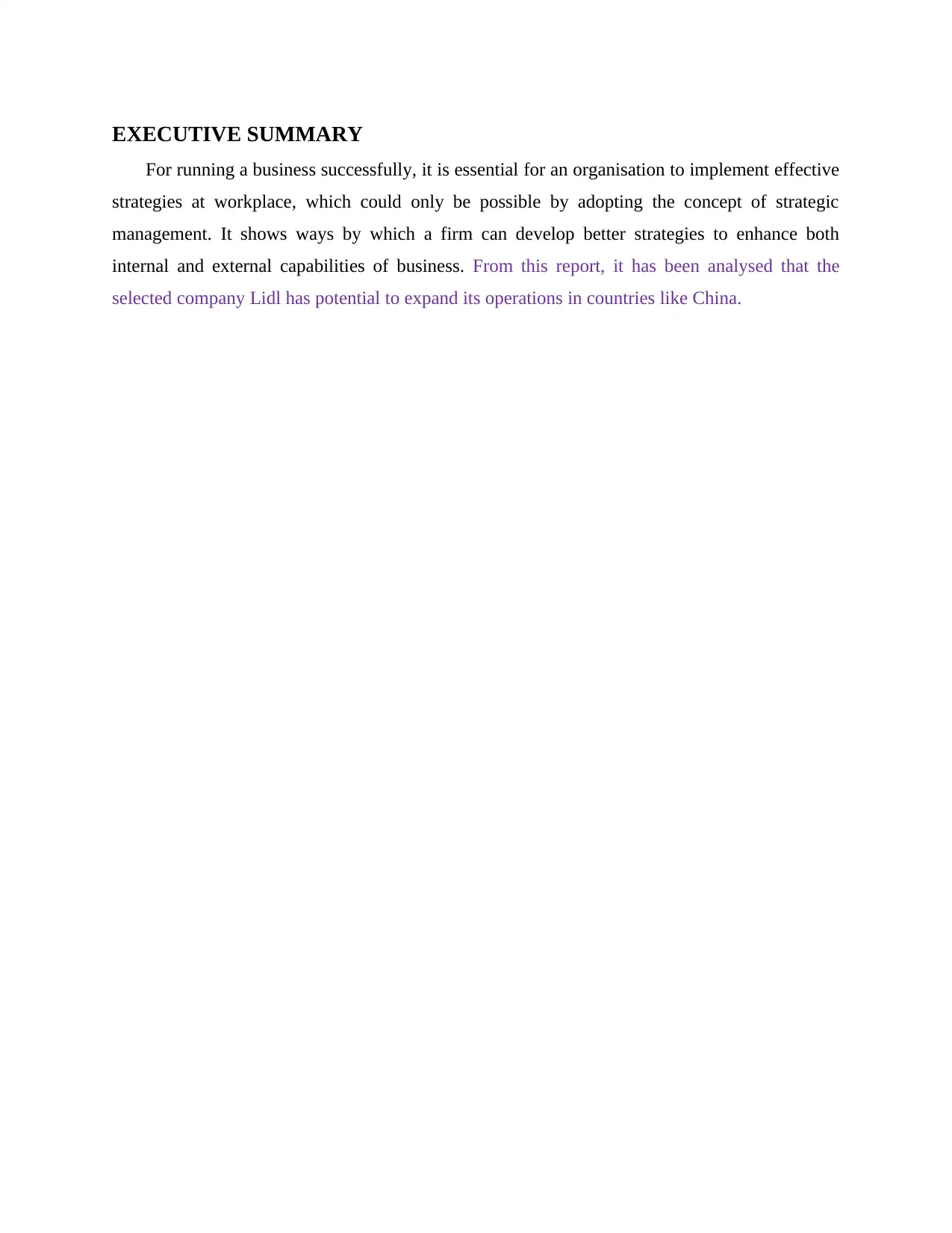
EXECUTIVE SUMMARY
For running a business successfully, it is essential for an organisation to implement effective
strategies at workplace, which could only be possible by adopting the concept of strategic
management. It shows ways by which a firm can develop better strategies to enhance both
internal and external capabilities of business. From this report, it has been analysed that the
selected company Lidl has potential to expand its operations in countries like China.
For running a business successfully, it is essential for an organisation to implement effective
strategies at workplace, which could only be possible by adopting the concept of strategic
management. It shows ways by which a firm can develop better strategies to enhance both
internal and external capabilities of business. From this report, it has been analysed that the
selected company Lidl has potential to expand its operations in countries like China.
⊘ This is a preview!⊘
Do you want full access?
Subscribe today to unlock all pages.

Trusted by 1+ million students worldwide
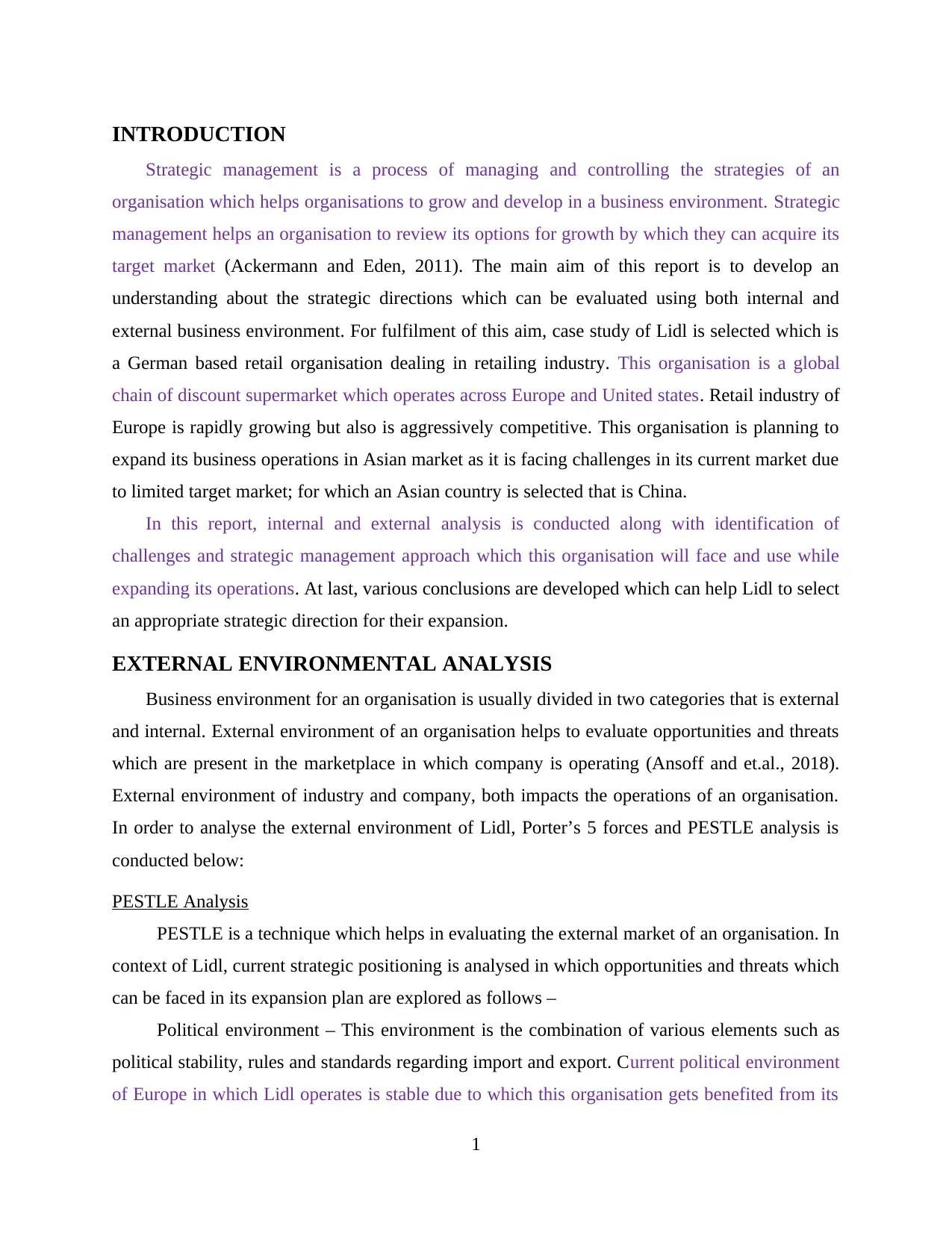
INTRODUCTION
Strategic management is a process of managing and controlling the strategies of an
organisation which helps organisations to grow and develop in a business environment. Strategic
management helps an organisation to review its options for growth by which they can acquire its
target market (Ackermann and Eden, 2011). The main aim of this report is to develop an
understanding about the strategic directions which can be evaluated using both internal and
external business environment. For fulfilment of this aim, case study of Lidl is selected which is
a German based retail organisation dealing in retailing industry. This organisation is a global
chain of discount supermarket which operates across Europe and United states. Retail industry of
Europe is rapidly growing but also is aggressively competitive. This organisation is planning to
expand its business operations in Asian market as it is facing challenges in its current market due
to limited target market; for which an Asian country is selected that is China.
In this report, internal and external analysis is conducted along with identification of
challenges and strategic management approach which this organisation will face and use while
expanding its operations. At last, various conclusions are developed which can help Lidl to select
an appropriate strategic direction for their expansion.
EXTERNAL ENVIRONMENTAL ANALYSIS
Business environment for an organisation is usually divided in two categories that is external
and internal. External environment of an organisation helps to evaluate opportunities and threats
which are present in the marketplace in which company is operating (Ansoff and et.al., 2018).
External environment of industry and company, both impacts the operations of an organisation.
In order to analyse the external environment of Lidl, Porter’s 5 forces and PESTLE analysis is
conducted below:
PESTLE Analysis
PESTLE is a technique which helps in evaluating the external market of an organisation. In
context of Lidl, current strategic positioning is analysed in which opportunities and threats which
can be faced in its expansion plan are explored as follows –
Political environment – This environment is the combination of various elements such as
political stability, rules and standards regarding import and export. Current political environment
of Europe in which Lidl operates is stable due to which this organisation gets benefited from its
1
Strategic management is a process of managing and controlling the strategies of an
organisation which helps organisations to grow and develop in a business environment. Strategic
management helps an organisation to review its options for growth by which they can acquire its
target market (Ackermann and Eden, 2011). The main aim of this report is to develop an
understanding about the strategic directions which can be evaluated using both internal and
external business environment. For fulfilment of this aim, case study of Lidl is selected which is
a German based retail organisation dealing in retailing industry. This organisation is a global
chain of discount supermarket which operates across Europe and United states. Retail industry of
Europe is rapidly growing but also is aggressively competitive. This organisation is planning to
expand its business operations in Asian market as it is facing challenges in its current market due
to limited target market; for which an Asian country is selected that is China.
In this report, internal and external analysis is conducted along with identification of
challenges and strategic management approach which this organisation will face and use while
expanding its operations. At last, various conclusions are developed which can help Lidl to select
an appropriate strategic direction for their expansion.
EXTERNAL ENVIRONMENTAL ANALYSIS
Business environment for an organisation is usually divided in two categories that is external
and internal. External environment of an organisation helps to evaluate opportunities and threats
which are present in the marketplace in which company is operating (Ansoff and et.al., 2018).
External environment of industry and company, both impacts the operations of an organisation.
In order to analyse the external environment of Lidl, Porter’s 5 forces and PESTLE analysis is
conducted below:
PESTLE Analysis
PESTLE is a technique which helps in evaluating the external market of an organisation. In
context of Lidl, current strategic positioning is analysed in which opportunities and threats which
can be faced in its expansion plan are explored as follows –
Political environment – This environment is the combination of various elements such as
political stability, rules and standards regarding import and export. Current political environment
of Europe in which Lidl operates is stable due to which this organisation gets benefited from its
1
Paraphrase This Document
Need a fresh take? Get an instant paraphrase of this document with our AI Paraphraser
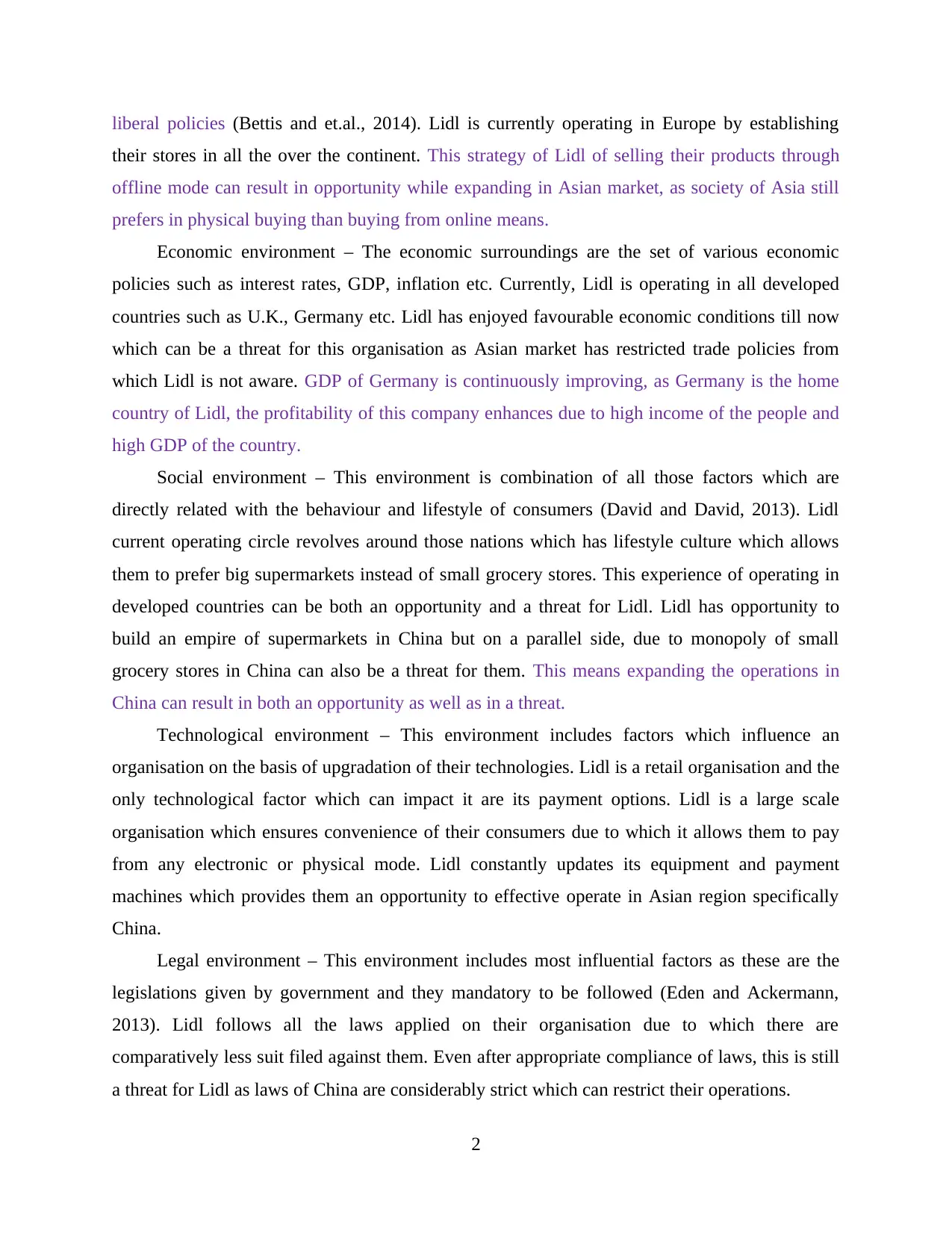
liberal policies (Bettis and et.al., 2014). Lidl is currently operating in Europe by establishing
their stores in all the over the continent. This strategy of Lidl of selling their products through
offline mode can result in opportunity while expanding in Asian market, as society of Asia still
prefers in physical buying than buying from online means.
Economic environment – The economic surroundings are the set of various economic
policies such as interest rates, GDP, inflation etc. Currently, Lidl is operating in all developed
countries such as U.K., Germany etc. Lidl has enjoyed favourable economic conditions till now
which can be a threat for this organisation as Asian market has restricted trade policies from
which Lidl is not aware. GDP of Germany is continuously improving, as Germany is the home
country of Lidl, the profitability of this company enhances due to high income of the people and
high GDP of the country.
Social environment – This environment is combination of all those factors which are
directly related with the behaviour and lifestyle of consumers (David and David, 2013). Lidl
current operating circle revolves around those nations which has lifestyle culture which allows
them to prefer big supermarkets instead of small grocery stores. This experience of operating in
developed countries can be both an opportunity and a threat for Lidl. Lidl has opportunity to
build an empire of supermarkets in China but on a parallel side, due to monopoly of small
grocery stores in China can also be a threat for them. This means expanding the operations in
China can result in both an opportunity as well as in a threat.
Technological environment – This environment includes factors which influence an
organisation on the basis of upgradation of their technologies. Lidl is a retail organisation and the
only technological factor which can impact it are its payment options. Lidl is a large scale
organisation which ensures convenience of their consumers due to which it allows them to pay
from any electronic or physical mode. Lidl constantly updates its equipment and payment
machines which provides them an opportunity to effective operate in Asian region specifically
China.
Legal environment – This environment includes most influential factors as these are the
legislations given by government and they mandatory to be followed (Eden and Ackermann,
2013). Lidl follows all the laws applied on their organisation due to which there are
comparatively less suit filed against them. Even after appropriate compliance of laws, this is still
a threat for Lidl as laws of China are considerably strict which can restrict their operations.
2
their stores in all the over the continent. This strategy of Lidl of selling their products through
offline mode can result in opportunity while expanding in Asian market, as society of Asia still
prefers in physical buying than buying from online means.
Economic environment – The economic surroundings are the set of various economic
policies such as interest rates, GDP, inflation etc. Currently, Lidl is operating in all developed
countries such as U.K., Germany etc. Lidl has enjoyed favourable economic conditions till now
which can be a threat for this organisation as Asian market has restricted trade policies from
which Lidl is not aware. GDP of Germany is continuously improving, as Germany is the home
country of Lidl, the profitability of this company enhances due to high income of the people and
high GDP of the country.
Social environment – This environment is combination of all those factors which are
directly related with the behaviour and lifestyle of consumers (David and David, 2013). Lidl
current operating circle revolves around those nations which has lifestyle culture which allows
them to prefer big supermarkets instead of small grocery stores. This experience of operating in
developed countries can be both an opportunity and a threat for Lidl. Lidl has opportunity to
build an empire of supermarkets in China but on a parallel side, due to monopoly of small
grocery stores in China can also be a threat for them. This means expanding the operations in
China can result in both an opportunity as well as in a threat.
Technological environment – This environment includes factors which influence an
organisation on the basis of upgradation of their technologies. Lidl is a retail organisation and the
only technological factor which can impact it are its payment options. Lidl is a large scale
organisation which ensures convenience of their consumers due to which it allows them to pay
from any electronic or physical mode. Lidl constantly updates its equipment and payment
machines which provides them an opportunity to effective operate in Asian region specifically
China.
Legal environment – This environment includes most influential factors as these are the
legislations given by government and they mandatory to be followed (Eden and Ackermann,
2013). Lidl follows all the laws applied on their organisation due to which there are
comparatively less suit filed against them. Even after appropriate compliance of laws, this is still
a threat for Lidl as laws of China are considerably strict which can restrict their operations.
2
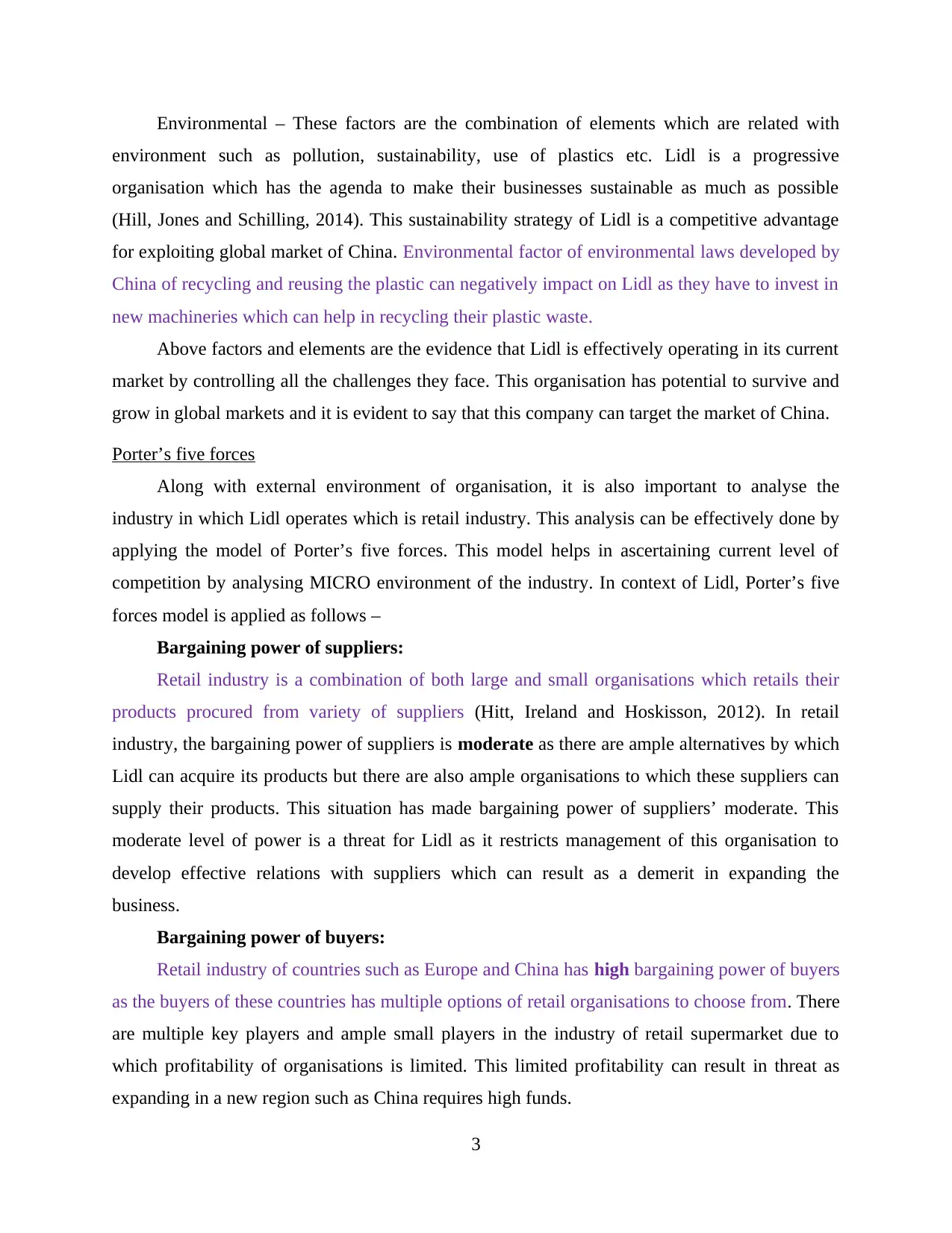
Environmental – These factors are the combination of elements which are related with
environment such as pollution, sustainability, use of plastics etc. Lidl is a progressive
organisation which has the agenda to make their businesses sustainable as much as possible
(Hill, Jones and Schilling, 2014). This sustainability strategy of Lidl is a competitive advantage
for exploiting global market of China. Environmental factor of environmental laws developed by
China of recycling and reusing the plastic can negatively impact on Lidl as they have to invest in
new machineries which can help in recycling their plastic waste.
Above factors and elements are the evidence that Lidl is effectively operating in its current
market by controlling all the challenges they face. This organisation has potential to survive and
grow in global markets and it is evident to say that this company can target the market of China.
Porter’s five forces
Along with external environment of organisation, it is also important to analyse the
industry in which Lidl operates which is retail industry. This analysis can be effectively done by
applying the model of Porter’s five forces. This model helps in ascertaining current level of
competition by analysing MICRO environment of the industry. In context of Lidl, Porter’s five
forces model is applied as follows –
Bargaining power of suppliers:
Retail industry is a combination of both large and small organisations which retails their
products procured from variety of suppliers (Hitt, Ireland and Hoskisson, 2012). In retail
industry, the bargaining power of suppliers is moderate as there are ample alternatives by which
Lidl can acquire its products but there are also ample organisations to which these suppliers can
supply their products. This situation has made bargaining power of suppliers’ moderate. This
moderate level of power is a threat for Lidl as it restricts management of this organisation to
develop effective relations with suppliers which can result as a demerit in expanding the
business.
Bargaining power of buyers:
Retail industry of countries such as Europe and China has high bargaining power of buyers
as the buyers of these countries has multiple options of retail organisations to choose from. There
are multiple key players and ample small players in the industry of retail supermarket due to
which profitability of organisations is limited. This limited profitability can result in threat as
expanding in a new region such as China requires high funds.
3
environment such as pollution, sustainability, use of plastics etc. Lidl is a progressive
organisation which has the agenda to make their businesses sustainable as much as possible
(Hill, Jones and Schilling, 2014). This sustainability strategy of Lidl is a competitive advantage
for exploiting global market of China. Environmental factor of environmental laws developed by
China of recycling and reusing the plastic can negatively impact on Lidl as they have to invest in
new machineries which can help in recycling their plastic waste.
Above factors and elements are the evidence that Lidl is effectively operating in its current
market by controlling all the challenges they face. This organisation has potential to survive and
grow in global markets and it is evident to say that this company can target the market of China.
Porter’s five forces
Along with external environment of organisation, it is also important to analyse the
industry in which Lidl operates which is retail industry. This analysis can be effectively done by
applying the model of Porter’s five forces. This model helps in ascertaining current level of
competition by analysing MICRO environment of the industry. In context of Lidl, Porter’s five
forces model is applied as follows –
Bargaining power of suppliers:
Retail industry is a combination of both large and small organisations which retails their
products procured from variety of suppliers (Hitt, Ireland and Hoskisson, 2012). In retail
industry, the bargaining power of suppliers is moderate as there are ample alternatives by which
Lidl can acquire its products but there are also ample organisations to which these suppliers can
supply their products. This situation has made bargaining power of suppliers’ moderate. This
moderate level of power is a threat for Lidl as it restricts management of this organisation to
develop effective relations with suppliers which can result as a demerit in expanding the
business.
Bargaining power of buyers:
Retail industry of countries such as Europe and China has high bargaining power of buyers
as the buyers of these countries has multiple options of retail organisations to choose from. There
are multiple key players and ample small players in the industry of retail supermarket due to
which profitability of organisations is limited. This limited profitability can result in threat as
expanding in a new region such as China requires high funds.
3
⊘ This is a preview!⊘
Do you want full access?
Subscribe today to unlock all pages.

Trusted by 1+ million students worldwide
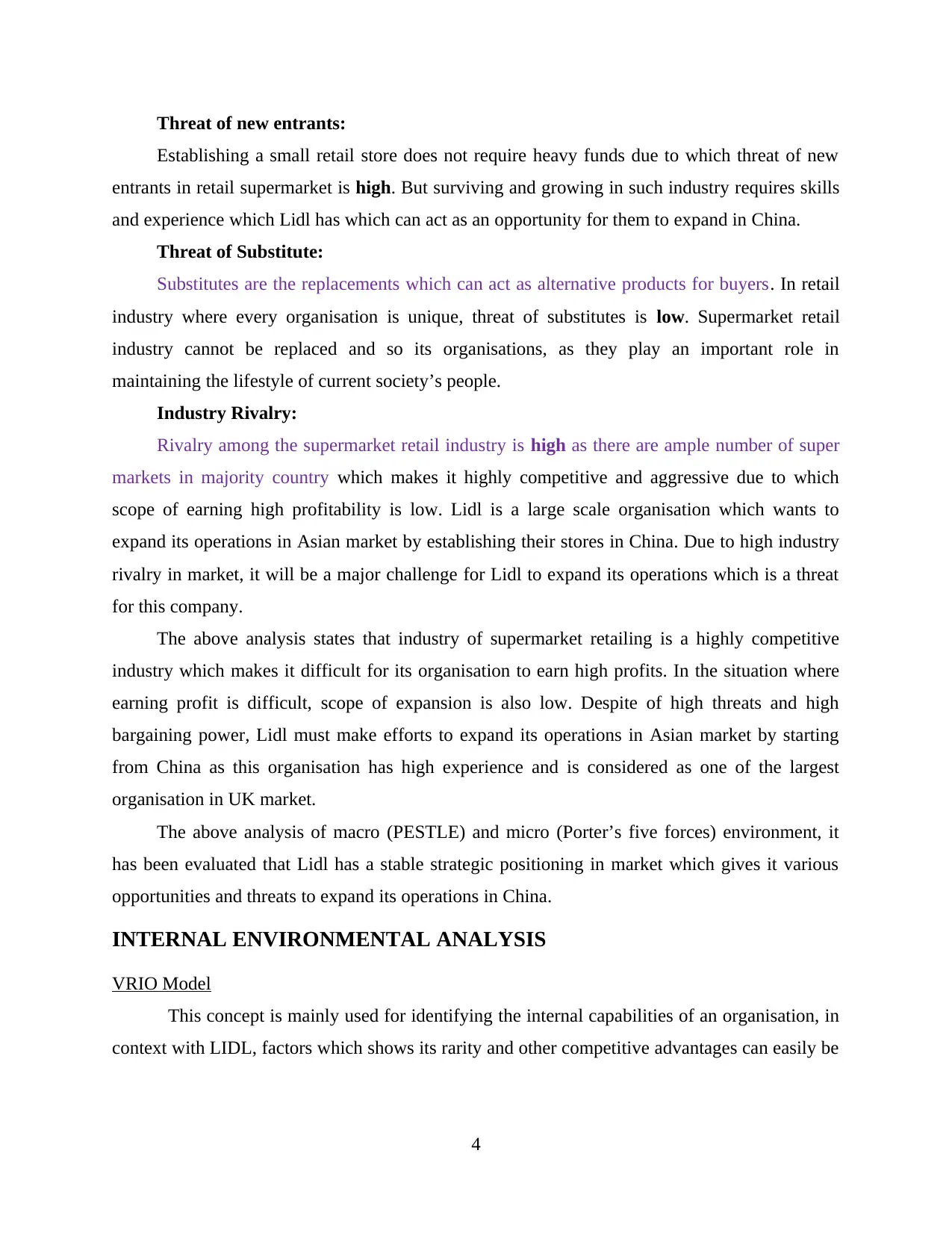
Threat of new entrants:
Establishing a small retail store does not require heavy funds due to which threat of new
entrants in retail supermarket is high. But surviving and growing in such industry requires skills
and experience which Lidl has which can act as an opportunity for them to expand in China.
Threat of Substitute:
Substitutes are the replacements which can act as alternative products for buyers. In retail
industry where every organisation is unique, threat of substitutes is low. Supermarket retail
industry cannot be replaced and so its organisations, as they play an important role in
maintaining the lifestyle of current society’s people.
Industry Rivalry:
Rivalry among the supermarket retail industry is high as there are ample number of super
markets in majority country which makes it highly competitive and aggressive due to which
scope of earning high profitability is low. Lidl is a large scale organisation which wants to
expand its operations in Asian market by establishing their stores in China. Due to high industry
rivalry in market, it will be a major challenge for Lidl to expand its operations which is a threat
for this company.
The above analysis states that industry of supermarket retailing is a highly competitive
industry which makes it difficult for its organisation to earn high profits. In the situation where
earning profit is difficult, scope of expansion is also low. Despite of high threats and high
bargaining power, Lidl must make efforts to expand its operations in Asian market by starting
from China as this organisation has high experience and is considered as one of the largest
organisation in UK market.
The above analysis of macro (PESTLE) and micro (Porter’s five forces) environment, it
has been evaluated that Lidl has a stable strategic positioning in market which gives it various
opportunities and threats to expand its operations in China.
INTERNAL ENVIRONMENTAL ANALYSIS
VRIO Model
This concept is mainly used for identifying the internal capabilities of an organisation, in
context with LIDL, factors which shows its rarity and other competitive advantages can easily be
4
Establishing a small retail store does not require heavy funds due to which threat of new
entrants in retail supermarket is high. But surviving and growing in such industry requires skills
and experience which Lidl has which can act as an opportunity for them to expand in China.
Threat of Substitute:
Substitutes are the replacements which can act as alternative products for buyers. In retail
industry where every organisation is unique, threat of substitutes is low. Supermarket retail
industry cannot be replaced and so its organisations, as they play an important role in
maintaining the lifestyle of current society’s people.
Industry Rivalry:
Rivalry among the supermarket retail industry is high as there are ample number of super
markets in majority country which makes it highly competitive and aggressive due to which
scope of earning high profitability is low. Lidl is a large scale organisation which wants to
expand its operations in Asian market by establishing their stores in China. Due to high industry
rivalry in market, it will be a major challenge for Lidl to expand its operations which is a threat
for this company.
The above analysis states that industry of supermarket retailing is a highly competitive
industry which makes it difficult for its organisation to earn high profits. In the situation where
earning profit is difficult, scope of expansion is also low. Despite of high threats and high
bargaining power, Lidl must make efforts to expand its operations in Asian market by starting
from China as this organisation has high experience and is considered as one of the largest
organisation in UK market.
The above analysis of macro (PESTLE) and micro (Porter’s five forces) environment, it
has been evaluated that Lidl has a stable strategic positioning in market which gives it various
opportunities and threats to expand its operations in China.
INTERNAL ENVIRONMENTAL ANALYSIS
VRIO Model
This concept is mainly used for identifying the internal capabilities of an organisation, in
context with LIDL, factors which shows its rarity and other competitive advantages can easily be
4
Paraphrase This Document
Need a fresh take? Get an instant paraphrase of this document with our AI Paraphraser
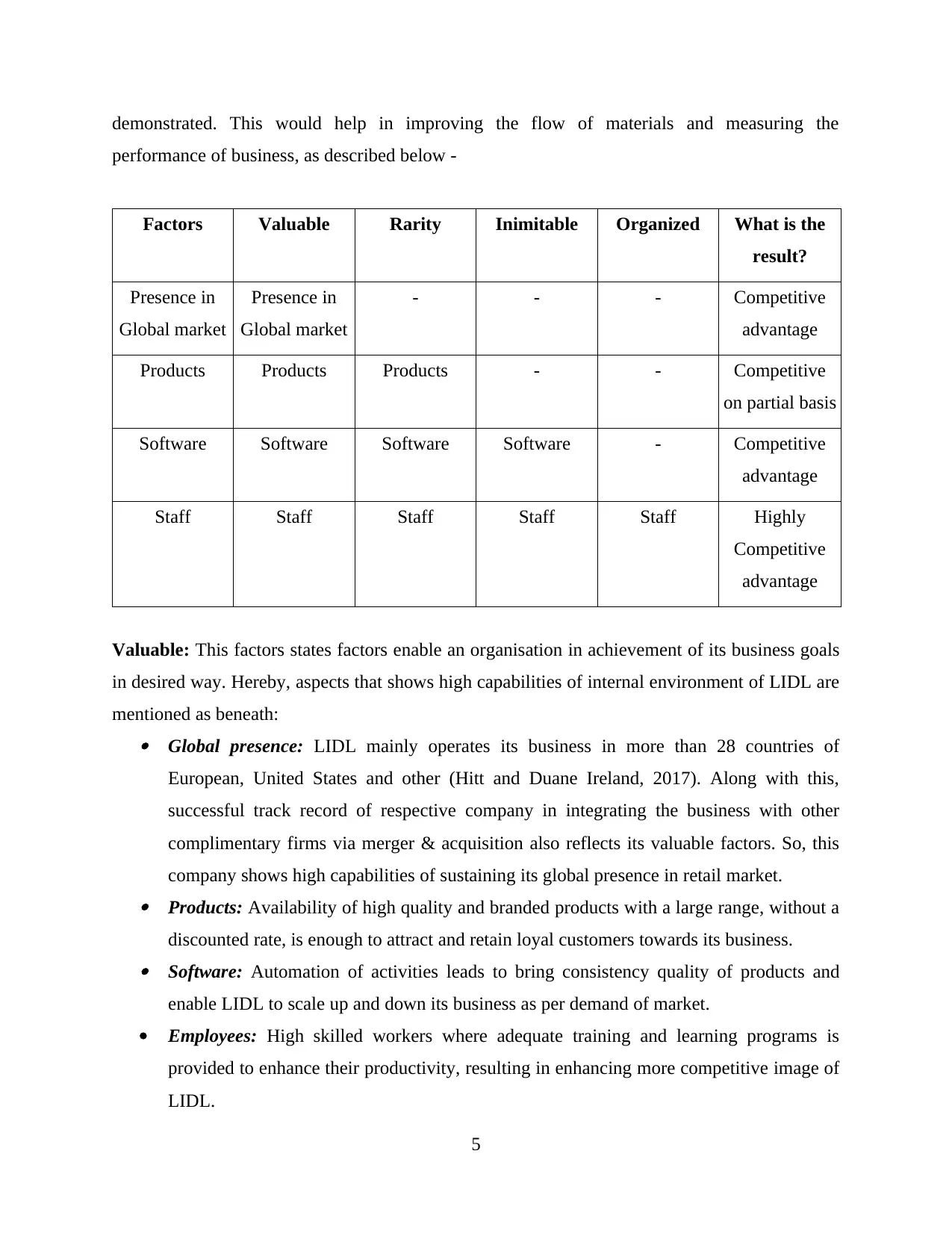
demonstrated. This would help in improving the flow of materials and measuring the
performance of business, as described below -
Factors Valuable Rarity Inimitable Organized What is the
result?
Presence in
Global market
Presence in
Global market
- - - Competitive
advantage
Products Products Products - - Competitive
on partial basis
Software Software Software Software - Competitive
advantage
Staff Staff Staff Staff Staff Highly
Competitive
advantage
Valuable: This factors states factors enable an organisation in achievement of its business goals
in desired way. Hereby, aspects that shows high capabilities of internal environment of LIDL are
mentioned as beneath: Global presence: LIDL mainly operates its business in more than 28 countries of
European, United States and other (Hitt and Duane Ireland, 2017). Along with this,
successful track record of respective company in integrating the business with other
complimentary firms via merger & acquisition also reflects its valuable factors. So, this
company shows high capabilities of sustaining its global presence in retail market. Products: Availability of high quality and branded products with a large range, without a
discounted rate, is enough to attract and retain loyal customers towards its business. Software: Automation of activities leads to bring consistency quality of products and
enable LIDL to scale up and down its business as per demand of market.
Employees: High skilled workers where adequate training and learning programs is
provided to enhance their productivity, resulting in enhancing more competitive image of
LIDL.
5
performance of business, as described below -
Factors Valuable Rarity Inimitable Organized What is the
result?
Presence in
Global market
Presence in
Global market
- - - Competitive
advantage
Products Products Products - - Competitive
on partial basis
Software Software Software Software - Competitive
advantage
Staff Staff Staff Staff Staff Highly
Competitive
advantage
Valuable: This factors states factors enable an organisation in achievement of its business goals
in desired way. Hereby, aspects that shows high capabilities of internal environment of LIDL are
mentioned as beneath: Global presence: LIDL mainly operates its business in more than 28 countries of
European, United States and other (Hitt and Duane Ireland, 2017). Along with this,
successful track record of respective company in integrating the business with other
complimentary firms via merger & acquisition also reflects its valuable factors. So, this
company shows high capabilities of sustaining its global presence in retail market. Products: Availability of high quality and branded products with a large range, without a
discounted rate, is enough to attract and retain loyal customers towards its business. Software: Automation of activities leads to bring consistency quality of products and
enable LIDL to scale up and down its business as per demand of market.
Employees: High skilled workers where adequate training and learning programs is
provided to enhance their productivity, resulting in enhancing more competitive image of
LIDL.
5
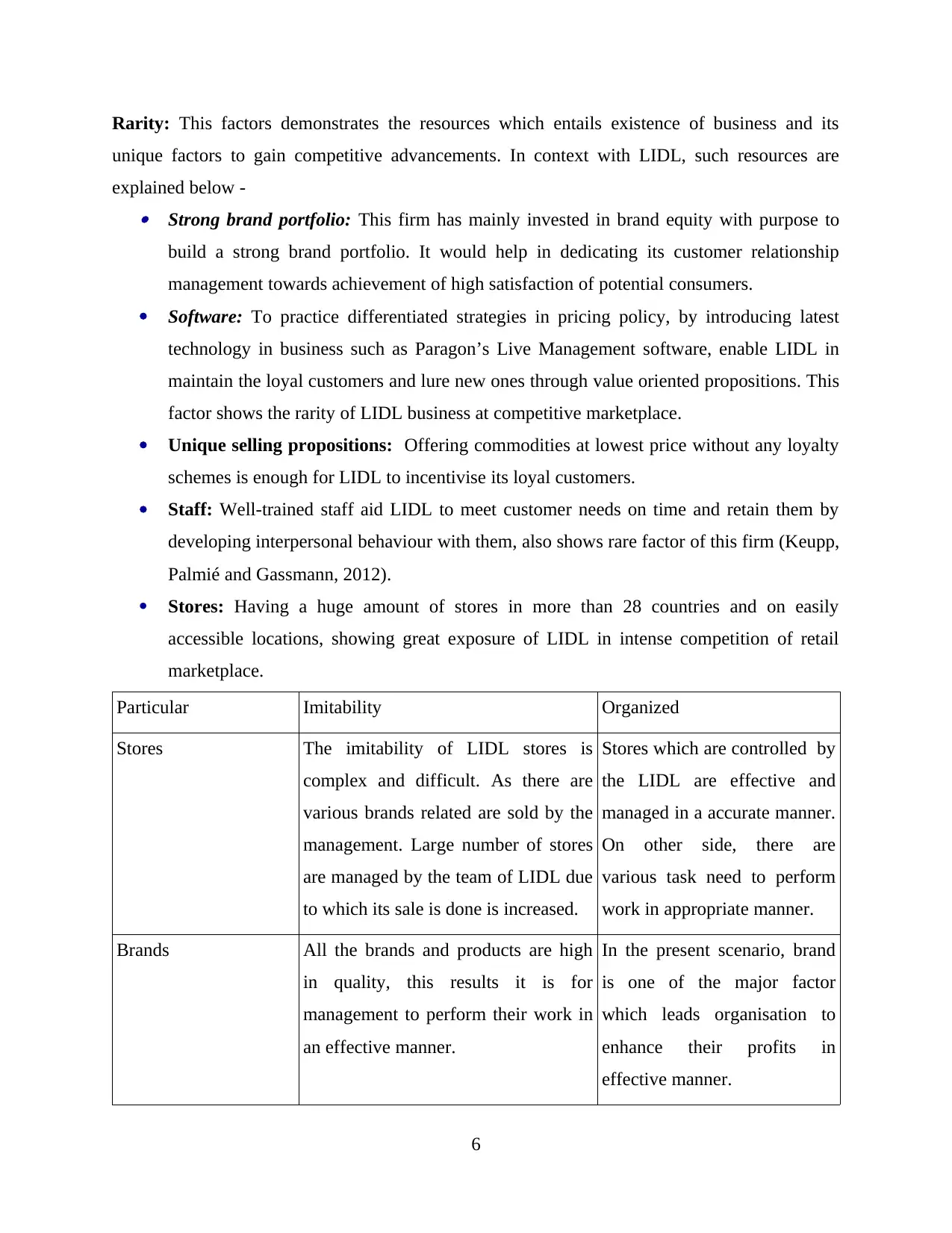
Rarity: This factors demonstrates the resources which entails existence of business and its
unique factors to gain competitive advancements. In context with LIDL, such resources are
explained below - Strong brand portfolio: This firm has mainly invested in brand equity with purpose to
build a strong brand portfolio. It would help in dedicating its customer relationship
management towards achievement of high satisfaction of potential consumers.
Software: To practice differentiated strategies in pricing policy, by introducing latest
technology in business such as Paragon’s Live Management software, enable LIDL in
maintain the loyal customers and lure new ones through value oriented propositions. This
factor shows the rarity of LIDL business at competitive marketplace.
Unique selling propositions: Offering commodities at lowest price without any loyalty
schemes is enough for LIDL to incentivise its loyal customers.
Staff: Well-trained staff aid LIDL to meet customer needs on time and retain them by
developing interpersonal behaviour with them, also shows rare factor of this firm (Keupp,
Palmié and Gassmann, 2012).
Stores: Having a huge amount of stores in more than 28 countries and on easily
accessible locations, showing great exposure of LIDL in intense competition of retail
marketplace.
Particular Imitability Organized
Stores The imitability of LIDL stores is
complex and difficult. As there are
various brands related are sold by the
management. Large number of stores
are managed by the team of LIDL due
to which its sale is done is increased.
Stores which are controlled by
the LIDL are effective and
managed in a accurate manner.
On other side, there are
various task need to perform
work in appropriate manner.
Brands All the brands and products are high
in quality, this results it is for
management to perform their work in
an effective manner.
In the present scenario, brand
is one of the major factor
which leads organisation to
enhance their profits in
effective manner.
6
unique factors to gain competitive advancements. In context with LIDL, such resources are
explained below - Strong brand portfolio: This firm has mainly invested in brand equity with purpose to
build a strong brand portfolio. It would help in dedicating its customer relationship
management towards achievement of high satisfaction of potential consumers.
Software: To practice differentiated strategies in pricing policy, by introducing latest
technology in business such as Paragon’s Live Management software, enable LIDL in
maintain the loyal customers and lure new ones through value oriented propositions. This
factor shows the rarity of LIDL business at competitive marketplace.
Unique selling propositions: Offering commodities at lowest price without any loyalty
schemes is enough for LIDL to incentivise its loyal customers.
Staff: Well-trained staff aid LIDL to meet customer needs on time and retain them by
developing interpersonal behaviour with them, also shows rare factor of this firm (Keupp,
Palmié and Gassmann, 2012).
Stores: Having a huge amount of stores in more than 28 countries and on easily
accessible locations, showing great exposure of LIDL in intense competition of retail
marketplace.
Particular Imitability Organized
Stores The imitability of LIDL stores is
complex and difficult. As there are
various brands related are sold by the
management. Large number of stores
are managed by the team of LIDL due
to which its sale is done is increased.
Stores which are controlled by
the LIDL are effective and
managed in a accurate manner.
On other side, there are
various task need to perform
work in appropriate manner.
Brands All the brands and products are high
in quality, this results it is for
management to perform their work in
an effective manner.
In the present scenario, brand
is one of the major factor
which leads organisation to
enhance their profits in
effective manner.
6
⊘ This is a preview!⊘
Do you want full access?
Subscribe today to unlock all pages.

Trusted by 1+ million students worldwide
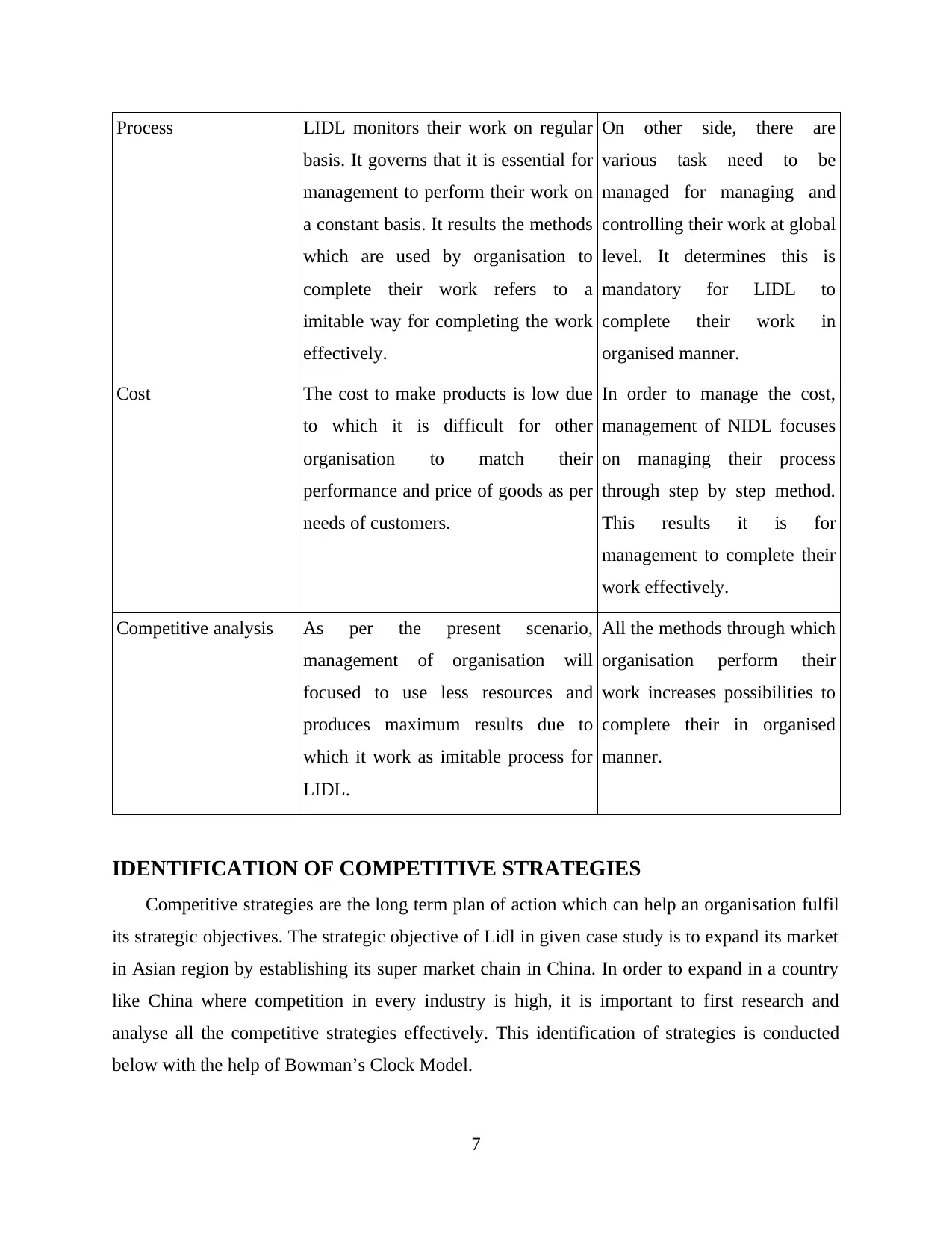
Process LIDL monitors their work on regular
basis. It governs that it is essential for
management to perform their work on
a constant basis. It results the methods
which are used by organisation to
complete their work refers to a
imitable way for completing the work
effectively.
On other side, there are
various task need to be
managed for managing and
controlling their work at global
level. It determines this is
mandatory for LIDL to
complete their work in
organised manner.
Cost The cost to make products is low due
to which it is difficult for other
organisation to match their
performance and price of goods as per
needs of customers.
In order to manage the cost,
management of NIDL focuses
on managing their process
through step by step method.
This results it is for
management to complete their
work effectively.
Competitive analysis As per the present scenario,
management of organisation will
focused to use less resources and
produces maximum results due to
which it work as imitable process for
LIDL.
All the methods through which
organisation perform their
work increases possibilities to
complete their in organised
manner.
IDENTIFICATION OF COMPETITIVE STRATEGIES
Competitive strategies are the long term plan of action which can help an organisation fulfil
its strategic objectives. The strategic objective of Lidl in given case study is to expand its market
in Asian region by establishing its super market chain in China. In order to expand in a country
like China where competition in every industry is high, it is important to first research and
analyse all the competitive strategies effectively. This identification of strategies is conducted
below with the help of Bowman’s Clock Model.
7
basis. It governs that it is essential for
management to perform their work on
a constant basis. It results the methods
which are used by organisation to
complete their work refers to a
imitable way for completing the work
effectively.
On other side, there are
various task need to be
managed for managing and
controlling their work at global
level. It determines this is
mandatory for LIDL to
complete their work in
organised manner.
Cost The cost to make products is low due
to which it is difficult for other
organisation to match their
performance and price of goods as per
needs of customers.
In order to manage the cost,
management of NIDL focuses
on managing their process
through step by step method.
This results it is for
management to complete their
work effectively.
Competitive analysis As per the present scenario,
management of organisation will
focused to use less resources and
produces maximum results due to
which it work as imitable process for
LIDL.
All the methods through which
organisation perform their
work increases possibilities to
complete their in organised
manner.
IDENTIFICATION OF COMPETITIVE STRATEGIES
Competitive strategies are the long term plan of action which can help an organisation fulfil
its strategic objectives. The strategic objective of Lidl in given case study is to expand its market
in Asian region by establishing its super market chain in China. In order to expand in a country
like China where competition in every industry is high, it is important to first research and
analyse all the competitive strategies effectively. This identification of strategies is conducted
below with the help of Bowman’s Clock Model.
7
Paraphrase This Document
Need a fresh take? Get an instant paraphrase of this document with our AI Paraphraser
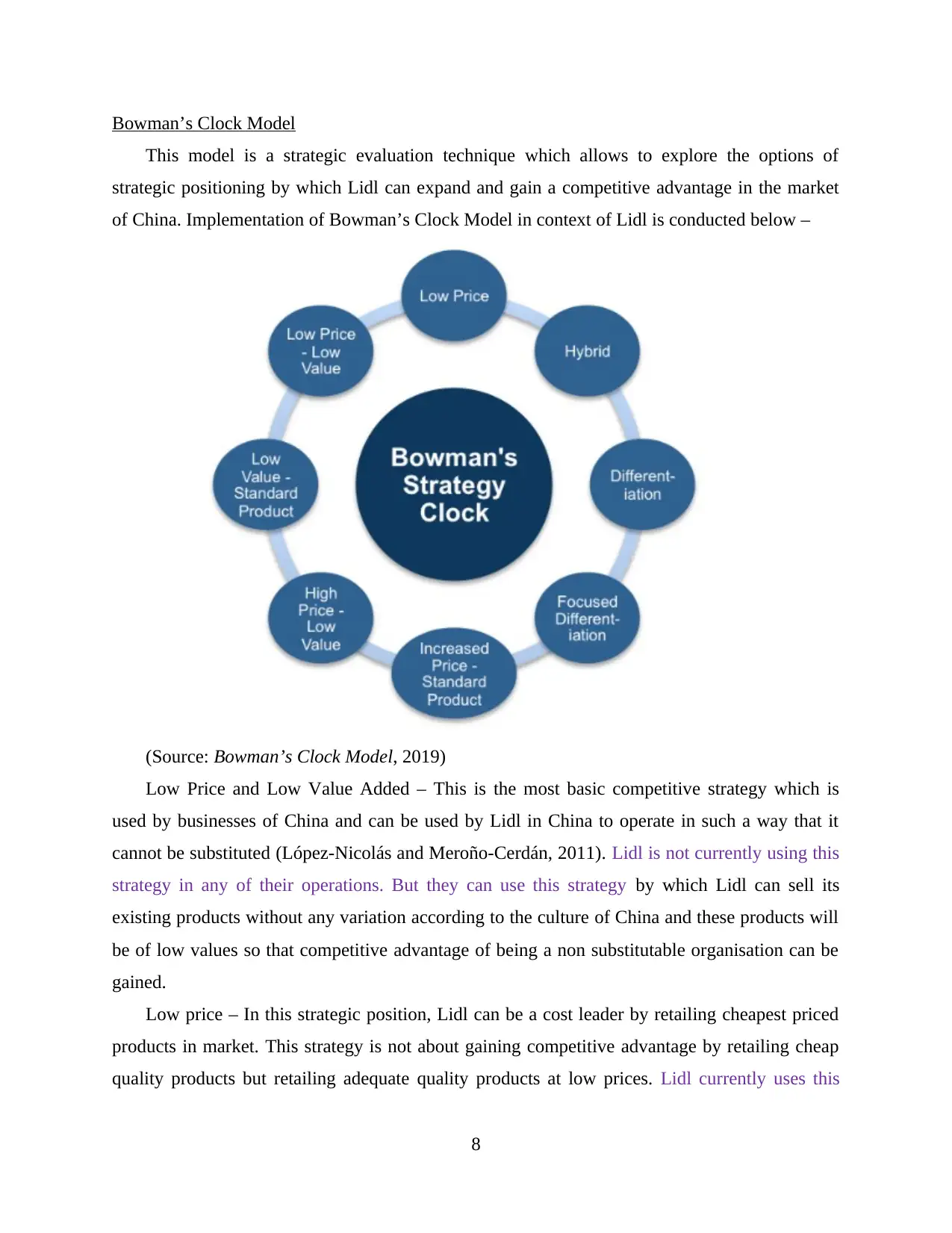
Bowman’s Clock Model
This model is a strategic evaluation technique which allows to explore the options of
strategic positioning by which Lidl can expand and gain a competitive advantage in the market
of China. Implementation of Bowman’s Clock Model in context of Lidl is conducted below –
(Source: Bowman’s Clock Model, 2019)
Low Price and Low Value Added – This is the most basic competitive strategy which is
used by businesses of China and can be used by Lidl in China to operate in such a way that it
cannot be substituted (López-Nicolás and Meroño-Cerdán, 2011). Lidl is not currently using this
strategy in any of their operations. But they can use this strategy by which Lidl can sell its
existing products without any variation according to the culture of China and these products will
be of low values so that competitive advantage of being a non substitutable organisation can be
gained.
Low price – In this strategic position, Lidl can be a cost leader by retailing cheapest priced
products in market. This strategy is not about gaining competitive advantage by retailing cheap
quality products but retailing adequate quality products at low prices. Lidl currently uses this
8
This model is a strategic evaluation technique which allows to explore the options of
strategic positioning by which Lidl can expand and gain a competitive advantage in the market
of China. Implementation of Bowman’s Clock Model in context of Lidl is conducted below –
(Source: Bowman’s Clock Model, 2019)
Low Price and Low Value Added – This is the most basic competitive strategy which is
used by businesses of China and can be used by Lidl in China to operate in such a way that it
cannot be substituted (López-Nicolás and Meroño-Cerdán, 2011). Lidl is not currently using this
strategy in any of their operations. But they can use this strategy by which Lidl can sell its
existing products without any variation according to the culture of China and these products will
be of low values so that competitive advantage of being a non substitutable organisation can be
gained.
Low price – In this strategic position, Lidl can be a cost leader by retailing cheapest priced
products in market. This strategy is not about gaining competitive advantage by retailing cheap
quality products but retailing adequate quality products at low prices. Lidl currently uses this
8
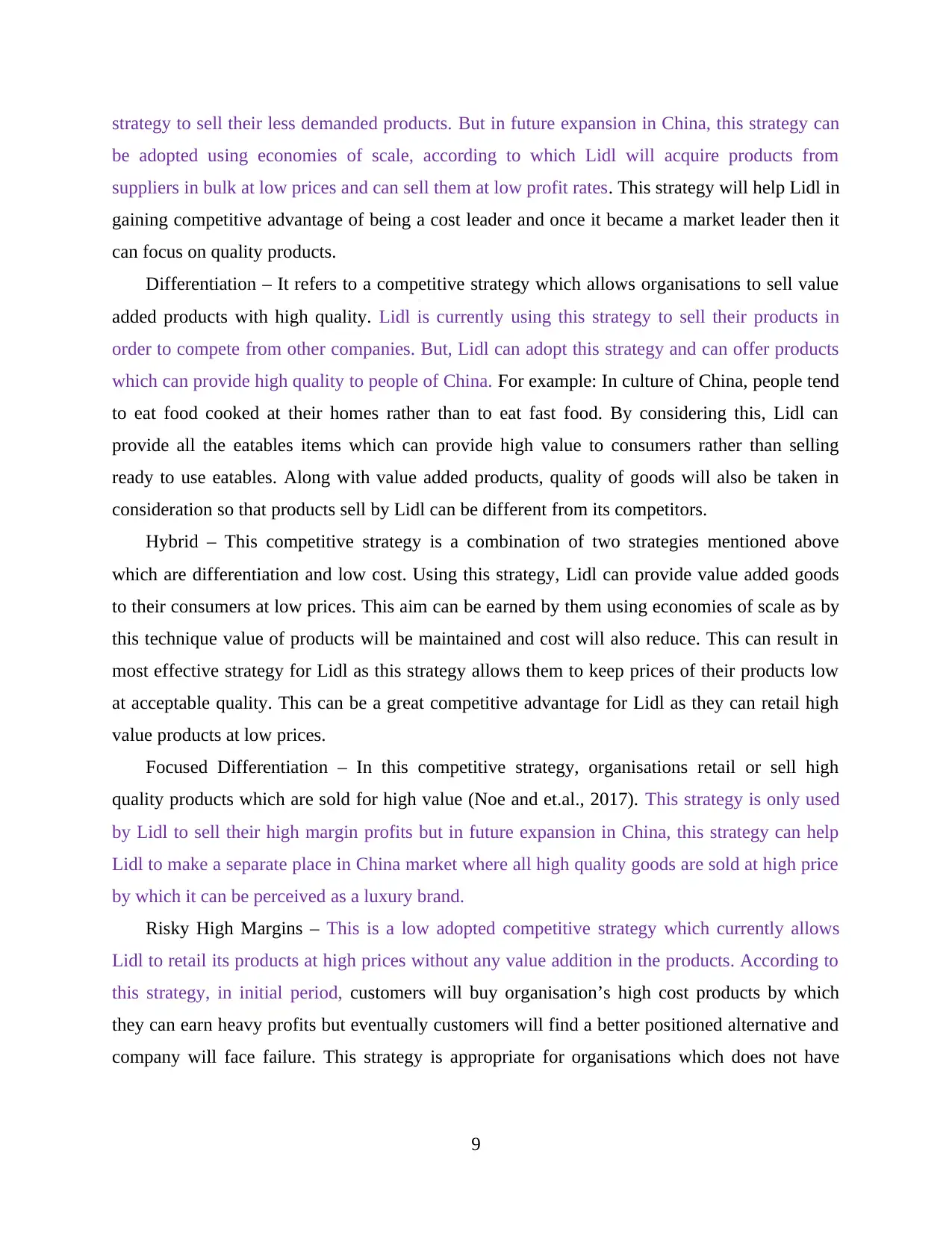
strategy to sell their less demanded products. But in future expansion in China, this strategy can
be adopted using economies of scale, according to which Lidl will acquire products from
suppliers in bulk at low prices and can sell them at low profit rates. This strategy will help Lidl in
gaining competitive advantage of being a cost leader and once it became a market leader then it
can focus on quality products.
Differentiation – It refers to a competitive strategy which allows organisations to sell value
added products with high quality. Lidl is currently using this strategy to sell their products in
order to compete from other companies. But, Lidl can adopt this strategy and can offer products
which can provide high quality to people of China. For example: In culture of China, people tend
to eat food cooked at their homes rather than to eat fast food. By considering this, Lidl can
provide all the eatables items which can provide high value to consumers rather than selling
ready to use eatables. Along with value added products, quality of goods will also be taken in
consideration so that products sell by Lidl can be different from its competitors.
Hybrid – This competitive strategy is a combination of two strategies mentioned above
which are differentiation and low cost. Using this strategy, Lidl can provide value added goods
to their consumers at low prices. This aim can be earned by them using economies of scale as by
this technique value of products will be maintained and cost will also reduce. This can result in
most effective strategy for Lidl as this strategy allows them to keep prices of their products low
at acceptable quality. This can be a great competitive advantage for Lidl as they can retail high
value products at low prices.
Focused Differentiation – In this competitive strategy, organisations retail or sell high
quality products which are sold for high value (Noe and et.al., 2017). This strategy is only used
by Lidl to sell their high margin profits but in future expansion in China, this strategy can help
Lidl to make a separate place in China market where all high quality goods are sold at high price
by which it can be perceived as a luxury brand.
Risky High Margins – This is a low adopted competitive strategy which currently allows
Lidl to retail its products at high prices without any value addition in the products. According to
this strategy, in initial period, customers will buy organisation’s high cost products by which
they can earn heavy profits but eventually customers will find a better positioned alternative and
company will face failure. This strategy is appropriate for organisations which does not have
9
be adopted using economies of scale, according to which Lidl will acquire products from
suppliers in bulk at low prices and can sell them at low profit rates. This strategy will help Lidl in
gaining competitive advantage of being a cost leader and once it became a market leader then it
can focus on quality products.
Differentiation – It refers to a competitive strategy which allows organisations to sell value
added products with high quality. Lidl is currently using this strategy to sell their products in
order to compete from other companies. But, Lidl can adopt this strategy and can offer products
which can provide high quality to people of China. For example: In culture of China, people tend
to eat food cooked at their homes rather than to eat fast food. By considering this, Lidl can
provide all the eatables items which can provide high value to consumers rather than selling
ready to use eatables. Along with value added products, quality of goods will also be taken in
consideration so that products sell by Lidl can be different from its competitors.
Hybrid – This competitive strategy is a combination of two strategies mentioned above
which are differentiation and low cost. Using this strategy, Lidl can provide value added goods
to their consumers at low prices. This aim can be earned by them using economies of scale as by
this technique value of products will be maintained and cost will also reduce. This can result in
most effective strategy for Lidl as this strategy allows them to keep prices of their products low
at acceptable quality. This can be a great competitive advantage for Lidl as they can retail high
value products at low prices.
Focused Differentiation – In this competitive strategy, organisations retail or sell high
quality products which are sold for high value (Noe and et.al., 2017). This strategy is only used
by Lidl to sell their high margin profits but in future expansion in China, this strategy can help
Lidl to make a separate place in China market where all high quality goods are sold at high price
by which it can be perceived as a luxury brand.
Risky High Margins – This is a low adopted competitive strategy which currently allows
Lidl to retail its products at high prices without any value addition in the products. According to
this strategy, in initial period, customers will buy organisation’s high cost products by which
they can earn heavy profits but eventually customers will find a better positioned alternative and
company will face failure. This strategy is appropriate for organisations which does not have
9
⊘ This is a preview!⊘
Do you want full access?
Subscribe today to unlock all pages.

Trusted by 1+ million students worldwide
1 out of 15
Related Documents
Your All-in-One AI-Powered Toolkit for Academic Success.
+13062052269
info@desklib.com
Available 24*7 on WhatsApp / Email
![[object Object]](/_next/static/media/star-bottom.7253800d.svg)
Unlock your academic potential
Copyright © 2020–2025 A2Z Services. All Rights Reserved. Developed and managed by ZUCOL.





